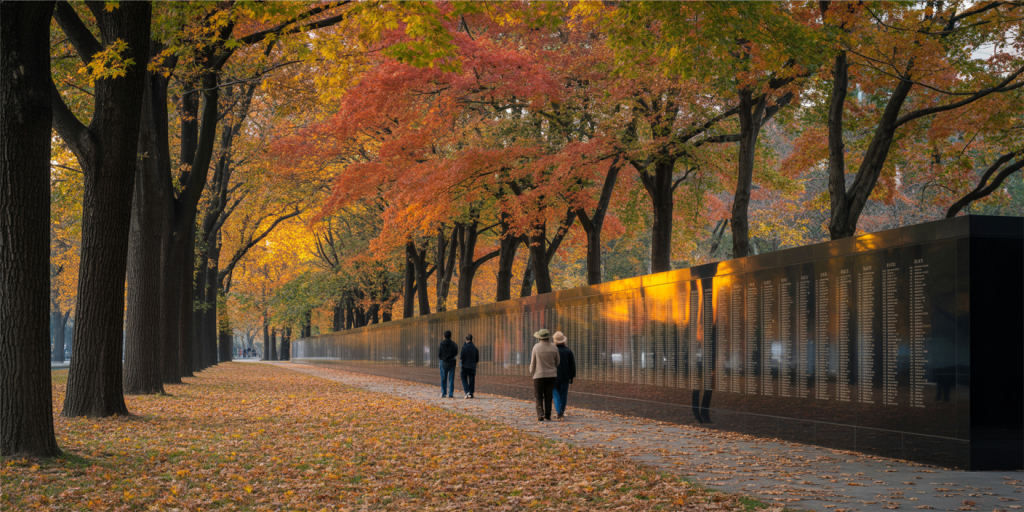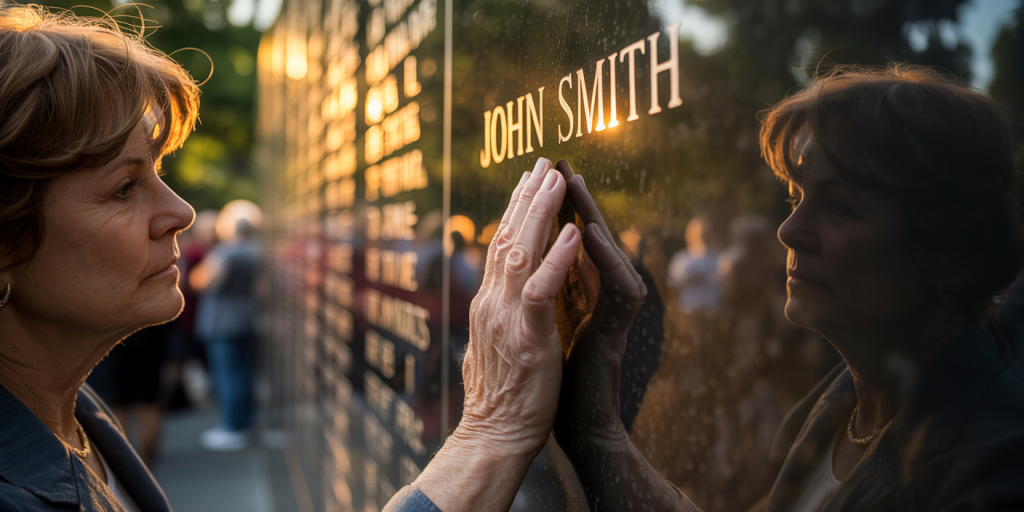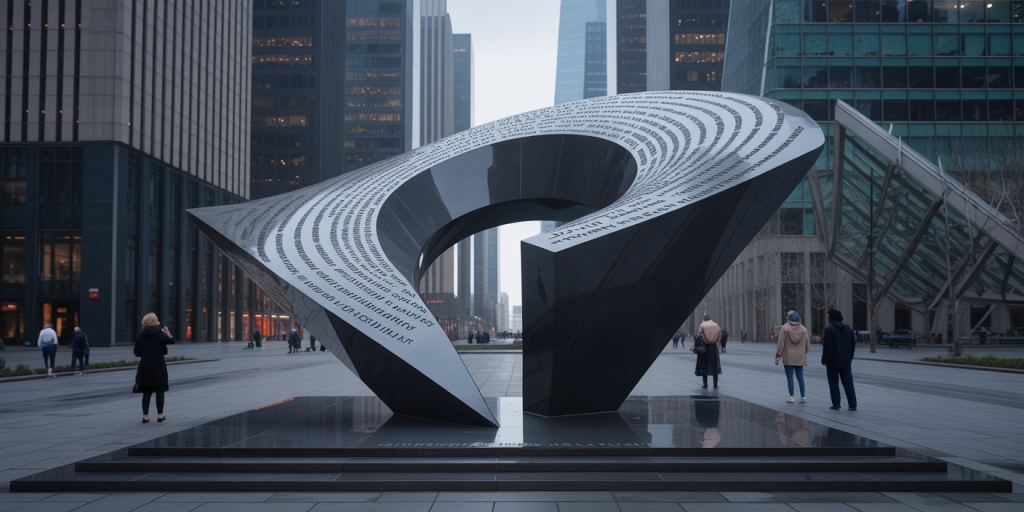Maya Lin and Mourning Sculpted with the Names of the World
In the hush between memory and marble, a whisper rises: names. They do not shout. They do not demand. They lie in the earth, inscribed in silence, like petals fallen in war. Maya Lin’s work does not build upward—it descends into absence. The Vietnam Veterans Memorial, perhaps her most renowned creation, does not pierce the sky like a monument of triumph, but opens the ground as a wound that refuses to heal. Grief is not erected in bronze here—it is etched, stretched across the polished black surface like the breath of mourning.
To stand before her work is to be absorbed by it, to become smaller, quieter. One is not looking at something but entering into it, entering a space where grief is not ornamental, not dramatic, but elemental. And from this void of black granite, something unspeakably human emerges: the litany of names.
Table of Contents
- The Shadow that Breathes in Stone
- Names as Echoes of Flesh
- The Earth as Wound and Altar
- Architecture of Absence
- The Surface that Reflects Us
- Letters Like Tears
- The Descent into Memory
- Silence as Material
- From Monument to Memorial
- The Body in the Black Mirror
- Elegy without Voice
- Geometry of Sorrow
- Materiality of Mourning
- Time Made Visible
- The Alphabet of Loss
- Shadows that Stretch at Noon
- The Horizon Buried in the Wall
- The Artist as Listener
The Shadow that Breathes in Stone
There is something uncanny about Lin’s granite. It does not feel inert. It seems to breathe, to tremble faintly under the weight of meaning. Like a long, silent exhale, the wall pulls the viewer downward and inward. This is no accidental geometry—its acute angle, its buried nature, its horizon line all conspire to simulate the pull of grief itself.
Here, shadow is not merely absence of light, but presence of memory. Each footstep echoes along its base like a quiet drumbeat of those who cannot return.
Names as Echoes of Flesh
Names are the core—names without rank, without embellishment. Just names. Like heartbeat echoes frozen in stone. Lin’s decision to strip the memorial of hierarchy deconstructs the military structure and rehumanizes each name. Each letter, equal in size and weight, becomes a body.
These names do not speak, but they listen. Their silence absorbs the viewer’s breath, inviting reflection, confrontation, sorrow.
The Earth as Wound and Altar
To walk along Lin’s wall is to traverse a laceration across the body of the nation. The wall slices the landscape, forming an altar that invites offerings not of gold, but of memory—photos, flowers, flags, tears.
It is both a wound and a site of reverence, transforming the National Mall into a space of ritual. The earth does not reject the dead; it holds them.
Architecture of Absence
There is no statue, no flag waving atop the memorial. Instead, Lin’s minimalist language speaks volumes through subtraction. Absence becomes the architecture—void as volume.
We feel not what is there, but what is no longer. It is the lost embraces, the interrupted lives, the things unsaid that rise within us.
The Surface that Reflects Us
Polished to mirror sheen, the granite reflects the living. One sees their face superimposed over the names—life overlapping death. That duality turns the memorial into a portal between now and then, between being and memory.
Grief becomes a dialogue—not just remembrance, but reckoning.
Letters Like Tears
Each name is cut with precision, yet each incision is a tear. The granite does not bleed, but the names wound the surface as surely as grief wounds the soul.
Some fingers trace the letters, as if to call the dead back by touch. The eye follows the lines like a mourner reading the Book of the Dead.
The Descent into Memory
The wall descends below ground level, guiding the viewer on a slope into the earth. This downward motion mirrors the act of mourning—digging inward, being pulled by the gravity of loss.
Yet, the path also rises again. The return is not triumphant but tender. Lin offers no closure, but a gesture toward continuity.
Silence as Material
Unlike traditional war memorials that shout valor and conquest, Lin’s whispers. Silence is not emptiness here—it is the substance of memory, the breath between names, the hush that falls when grief takes hold.
This silence is heavy, palpable. One does not talk near the wall; the wall speaks through the quiet.
From Monument to Memorial
Lin redefined what a memorial could be. She rejected the glorified language of statuary and instead embraced the landscape itself. The memorial is not imposed—it is unearthed.
Monuments celebrate. Memorials remember. Lin’s is a remembering so deep it lives in the soil.
The Body in the Black Mirror
The viewer becomes participant. The wall, like a mirror of obsidian, overlays the self onto the past. You see yourself reflected in history—not as a hero, not as a judge, but as a mourner.
This bodily interaction reanimates the dead. They do not reside behind the wall; they rise from its reflection.
Elegy without Voice
There is no inscription explaining the war. No summary, no narrative. The memorial resists explanation. Its eloquence is in its muteness.
This is an elegy written not in verses, but in granite. A requiem of presence, not prose.
Geometry of Sorrow
Two arms stretch from a central point like wings clipped. One points toward the Washington Monument, the other toward the Lincoln Memorial—bridging past and future, power and freedom.
This geometry is not decorative—it’s existential. The V shape suggests open arms, or a grave opening. Both are true.
Materiality of Mourning
Black granite—dense, reflective, unyielding. A material as grave as the subject. Its weight mirrors emotional gravity.
It resists time, like grief that doesn’t dull. Yet, like memory, it is susceptible to weathering—rain streaks, handprints, sunlight smudges. It evolves, even as it preserves.
Time Made Visible
The names are arranged chronologically, not alphabetically. This design transforms the wall into a timeline, a wave of mortality.
As one walks, one moves through time, through escalation and retreat, life and death. The earliest and latest names meet in the center, the place of stillness.
The Alphabet of Loss
Each letter is clean, chiseled, aligned. Yet behind these forms lies chaos: families shattered, futures erased. The orderliness contrasts with the disorder of war.
This contradiction haunts the viewer. Grief is not linear, but the names insist on sequence.
Shadows that Stretch at Noon
At high sun, the wall drinks in the light and throws long shadows. The names darken, become negative space. Mourning does not fade in daylight; it deepens.
Time of day becomes part of the experience. Dusk softens the edges, dawn cools the stone. The wall lives in rhythms.
The Horizon Buried in the Wall
Unlike most structures that reach toward the sky, Lin’s lies low. It follows the line of the earth. Horizon becomes memorial.
This challenges Western ideals of verticality and dominance. Instead of dominion, we see humility.
The Artist as Listener
Maya Lin was just 21 when she won the anonymous competition. Her youth allowed her to hear the voices of grief unfiltered by ideology.
She listened—not to politics, but to sorrow. Her design emerged from empathy, from understanding mourning as a universal language.



FAQ
Who is Maya Lin?
An American designer and artist, Maya Lin is best known for her minimalist and emotionally powerful Vietnam Veterans Memorial in Washington, D.C., which she designed as a Yale undergraduate in 1981.
Why was the memorial controversial at first?
Some critics felt the design was too minimal, too somber, and did not celebrate heroism. Others disliked the black granite or Lin’s Chinese-American heritage. However, public perception shifted as the memorial became a sacred space of remembrance.
What materials are used in the memorial?
Black granite was chosen for its durability and reflectivity. The material captures the viewer’s image and symbolizes both permanence and presence.
What is the symbolism of the wall’s shape?
The V-shaped design symbolizes a wound that is healing. It also connects two important American landmarks, situating the war within a larger historical and moral context.
How are the names arranged?
Chronologically by date of casualty, not alphabetically. This creates a narrative arc and reflects the emotional weight of time passing.
Final Reflections: Where Memory Touches Earth
Maya Lin’s memorial is not just a structure—it is an experience, a pilgrimage, a mirror. It does not resolve grief; it honors it. It does not glorify war; it remembers those lost within it.
The black granite wall, inscribed with names, becomes a map of mourning. Each name a star fallen, each visitor a comet passing through silence. Lin does not offer answers. She offers a space where grief can breathe.
Here, memory has mass. Loss has geometry. And the earth itself, shaped by hands and hearts, becomes the ultimate canvas for remembrance.
